By: debbie lynn elias
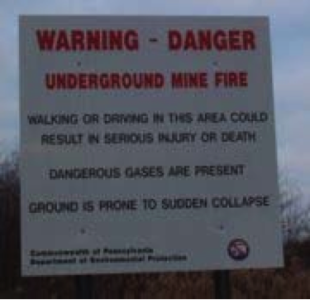
A competitor in the Documentary category at the 2007 Los Angeles Film Festival, if there was ever a film predestined for me to review, this one could be it. If there was ever a documentary you need to see, it is this one.
Centralia is located in Columbia County, Pennsylvania, a few hours northwest of Philadelphia and near the Columbia County seat of Bloomsburg. Other than my recollection of current events stories in school about the underground fires back in the 1960’s and that the area was a vital part of the State’s economy thanks to its rich veins of anthracite, I didn’t know a lot about the town. My real education on Centralia began thanks to my friend and fellow Philadelphian, New York Times best-selling author, Lisa Scottoline. Her 2006 best selling legal thriller, “Dirty Blonde” is inspired by the burning of the underground Centralia mine fires which according to newspaper accounts and Pennsylvania factual history the fires have actually been burning in some fashion for 50+ years, and the corporate and governmental corruption that surrounded the destruction of the town. Having talked with Lisa about her experiences in Centralia while doing her research and looking at her own photos of the area, as well as talking to my sister-in-law who frequently drives through Centralia and whose grandfathers worked in the area coal mines, I can only tell you how impressed and moved I am with the job that Chris Perkel and Georgie Roland have done with THE TOWN THAT WAS. Told through the eyes of John Lokotis, the youngest remaining resident in Centralia, the story is poignant, heartfelt and educational.
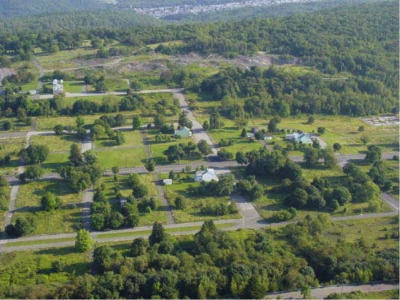
Founded in about 1841, Centralia’s first business was the Bull’s Head Tavern opened by Johnathan Faust. In 1854, a civil mining engineer for the Locust Mountain Coal and Iron Company named Alexander Rea, laid out the city street plans. 1865 brought a name change from Cetreville to Centralia and the post office was established there. And the primary business in the area – mining of anthracite coal. Mining was the primary occupation until the mid 1960’s when most of the major companies went out of business leaving the bootleggers to do the dirty work through the 1980’s. Serviced by both the Philadelphia and Reading Railroad and the Lehigh Valley Railroad, Centralia had its own school district, two Catholic schools, seven churches, five hotels, a bank, the post office, two movie theatres, over 14 grocery stores and 27 bars. For most of its 160+ year history, Centralia had a population of over 2000 with 500 to 600 residents in its suburbs.

But things started to change when an exposed vein of coal ignited during the borough’s weekly and coincidentally, post-Memorial Day celebration clean up, burning garbage in its landfill which just happened to be located in an abandoned mine pit near St. Ignatius Church. Flames apparently fell through cracks in the pit igniting the coal. Unable to be doused, the fire burned through the 60’s and 70’s causing “sudden” outbreaks of health issues among the residents. I remember doing current events in school about the “underground fires” which were more of a sensationalist news story than one prompting government action or attention to health care. But in 1979 things changed when a local gas station owner checked the fuel level of one of his underground tanks. When he pulled out the dipstick it seemed hot, really hot, so he checked the tank’s temperature. It was 172 degrees. It still took another two years before governmental attention was paid and that was only a result of a fall by 12 year old Todd Domboski into a 150 foot deep sinkhole that just opened beneath him. Saved by his cousin, it was this incident that prompted an investigation into Centralia.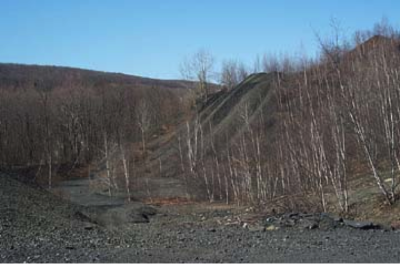
Filmmakers Perkel and Roland provide a very balanced, heartfelt and moving look at the indomitable spirit of a man, John Lokotis, a time in history, and this town that he refuses to let die. The images are impeccable and incredibly moving and particularly for me, having seen Lisa’s actual photos of the sulphur steam rising from cracks in the sidewalk and knowing of her experiences and her own walking tour of the city, as well as my sister-in-law’s description of it being “weird” and “creepy” as you drive through the region. But seeing actual film footage of the death and destruction, the barren sulfur bleached trees, overgrown roadways, crumbled houses, empty churches, one majestic chimneys standing alone with no house to warm and listening to John Lokotis talk of his beloved home – the sadness and even rage that this story evokes is at times overwhelming. Thanks to Perkel’s keenly precise and expansive cinematography, one is made to feel a part of Centralia as if John Lokotis’ neighbor, garnering a great sense of what a vibrant town this was and the sorrow over not just its loss, but that of its residents. Most impactful is the interplay of archival news footage and interviews with former residents and politicians alike, adding fuel to John Lokotis’ fire. THE TOWN THAT WAS captures every possible emotion stemming from a “man made” disaster like this right and effectively utilizes the town’s cemetery as a stage.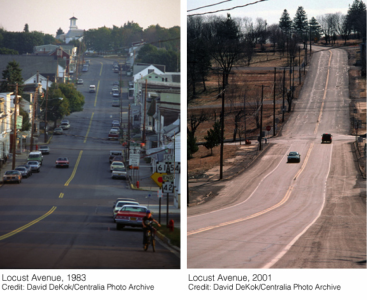
And while extremely informative, what Perkel and Roland have done is make the town the main character with Lokotis and the camera merely narrators giving voice to history and horror. Their imagery draws you deeper into the legend and life of Centralia or, “the poor man’s Dante’s Inferno” as it is known within the State of Pennsylvania and in mining communities throughout Appalachia. The interviews are compelling which lends to great fascination with Lokotis and his personal fortitude and determination, as well as giving rise to questions about our governmental processes and perhaps, the State’s desire to gain control over the mineral rights to the coal – an issue belied by the State of Pennsylvania but which looms in the hearts and minds of its former, and current, residents.
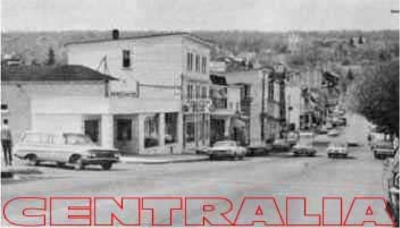
Everyone seems to be looking for horrors outside the US when we have had this ongoing death of a vital part of American history and economy staring us in the face for over half a century, yet so few today even give pause to the coal mining industry unless there is a cave-in somewhere in Tennessee or Virginia and it then becomes identifiable with a face or a name. How many people even know that the coal mining industry in the US has resulted in more occupational deaths than any other industry? And here, we have an entire town that has been in the throes of death for decades.
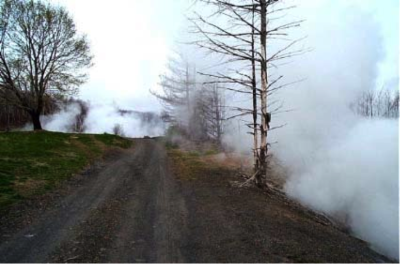
Ultimately, in 1984, Congress apportioned $42 million for relocation of Centralia’s residents. Holdouts to the bitter end, only eleven residents remained, John Lokotis being one. The resident relocation package offered by the State was not renewed in 2005. Although strip and open-pit mining is still active in the area and an underground mine three miles to the west of Centralia is still active and employs some 40 or so people, Centralia is now the least populous municipality in the State of Pennsylvania. In 1992, Pennsylvania invoked eminent domain on the entire borough and condemned the town. In 2002, the Post Office revoked Centralia’s zip code, 17927.

Today, there are little visible signs of fire, but for round metal steam vents, signs warning of underground fires, instability and lethal doses of carbon monoxide. Smoke and steam visibly rise form cracks in Route 61 which was closed in the mid 90’s. Located behind a hillside cemetery, the sulphurous smoke eerily rises from the death below. There are still no plans to extinguish the fire which now stretches through an eight mile seam, providing enough coal to burn for 250 years.
In 1981 when Todd Dombowski fell unto the sinkhole, the official census placed 1000 residents in Centralia proper. In March 2004, 18. By 2005, there were 12. Today in 2007, there are only 9. There were 11 when filming of this documentary began.
Filmed over the course of four years, from both an investigative news perspective and a filmmaking perspective, THE TOWN THAT WAS is a powerful testament to life. As long as there is one man standing like John Lokotis and filmmakers like Chris Perkel and Georgie Roland, Centralia will never die.
Written and Directed by Chris Perkel and Georgie Roland. With John Lokotis.












